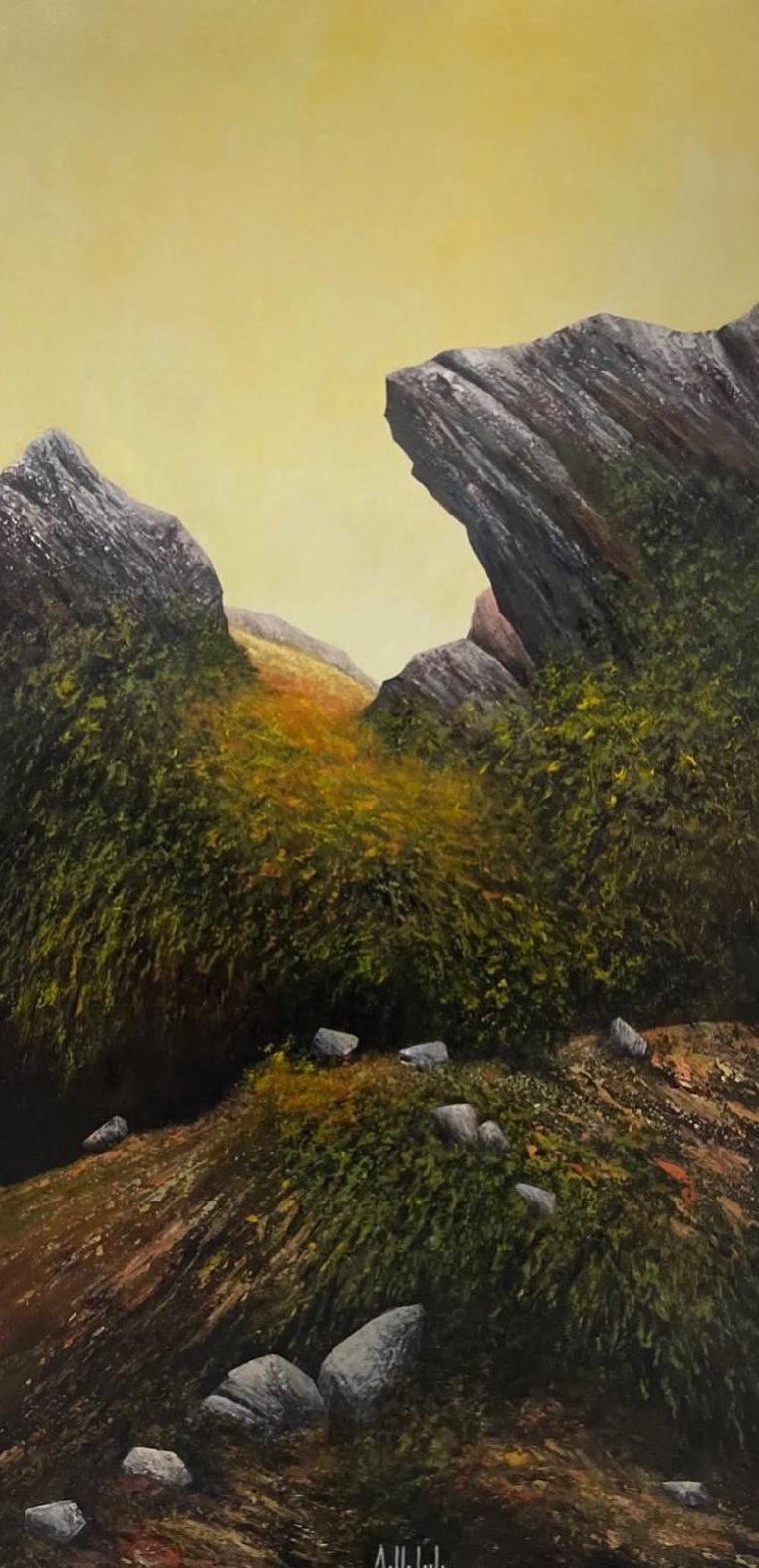Interview with Gino Dalle Luche
Gino, your paintings evoke a deep sense of place, rooted in the landscapes of Tuscany where you were born and still reside. How do you think your relationship with this land has evolved over the decades, and do you believe that the essence of a place can be fully translated into a canvas, or is there always anything elusive left behind?
Ever since I was a child, I’ve been fascinated by everything around me, especially by nature, with its trees changing color as the seasons passed.
I used to watch the trees from the window of my primary school and in the garden of my home.
Over the years, my connection with the land has deepened. With time, I discovered new things, and even today, all of this continues to inspire my work.
Every day represents a journey and a constant challenge, as I try to convey my feelings and emotions onto the canvas through color.
The thought that there is something elusive drives me to try and capture it with dedication and passion.
Your artistic journey is unique in that you are completely self-taught, forging your own path without formal instruction. In a world where artistic education is often considered a prerequisite for success, how has this independence shaped your creative process, and do you ever feel that institutional training would have altered the rawness or purity of your vision?
I began my artistic journey at a young age, carving out my own path day by day, without knowing whether it was truly the right one.
Since I was a child, I’ve always preferred manual activities over academic ones because I’ve always loved creating something out of nothing.
Perhaps it’s also my personality that led me to become a self-taught artist, experimenting with new techniques and creating my own style.
Over the years, I’ve faced obstacles, which I’ve overcome on my own, working every single day.
Being independent from any kind of formal artistic training has allowed me the freedom to create what I truly feel inside.
I’ve looked to some past artists as sources of inspiration, but never to imitate their style—always striving to create something uniquely mine.
To this day, I don’t know whether academic training would have altered the authenticity of my work, but knowing myself, I probably would have faced difficulties.
Your use of acrylic on canvas captures not just the physical landscape but a kind of emotional terrain—there’s a melancholic nostalgia that runs through many of your pieces. Do you view your work as a form of personal introspection, or do you seek to awaken memories and emotions within the viewer, making them an active participant in your art?
My paintings are the result of an analysis of my inner world, made up of thoughts, feelings, and emotions.
In my art, the canvas and the color represent the meeting point between what I feel and the external reality.
I try to convey my emotions and moods to those who observe my work, hoping to involve them and make them feel part of it.
I’ve always been committed to creating pieces that can transmit strong emotions and moments of serenity.
Color plays a central role in your paintings, with golden hues, deep greens, and rich earth tones creating a striking interplay between light and shadow. How do you approach color theory in your work—do you see colors as carriers of memory, mood, or even narrative? And are there particular color palettes you find yourself returning to instinctively?
I consider color a primary element, through which I can establish a connection with the viewer.
I believe that colors reflect emotions and moods; they are part of our lives and carry with them feelings, serenity, but also melancholy.
Colors also show us the passing of the seasons and influence our choices.
When I work, I live color to the fullest—every brushstroke is an emotion, which I hope is also felt by those who look at my art.
There are certain color palettes I return to instinctively and cannot do without, to create atmospheres and sensations.
I’ve dedicated much of my time to studying color, so that it could fully express my personality.
The trees in your paintings often appear twisted, leaning, or even fragmented—imbued with a sense of resilience and survival. Do you see these trees as metaphors for human struggle, endurance, or even transformation? What draws you to these particular forms, and do they represent a dialogue between nature and time?
Since ancient times, the tree has symbolized wisdom, strength, and prosperity.
The tree appears in most of my works and plays a central role—an undisturbed protagonist.
The trees I paint are curved and bent, much like people in certain moments of their lives: they appear weighed down by their problems, yet determined to overcome them.
Just as a tree, though bent and curved, withstands the test of time.
I’m drawn to unique shapes because I believe every tree is one of a kind—just like human beings, with their diverse appearances and personalities.
Many of your compositions contain architectural remnants—crumbling stone walls, abandoned paths, and hidden corners where nature reclaims human presence. Do these elements symbolize the impermanence of civilization, or do they suggest a coexistence between man-made structures and the relentless passage of nature?
While walking through the landscape, it’s common to come across abandoned architectural structures that take us back in time to distant moments of life, now covered and embraced by an overwhelming and beautiful nature.
Some of these structures remind me of my childhood. Looking at them, I feel a sense of resilience—a challenge against time not to be erased, a struggle with nature that’s determined to reclaim its space.
Despite their realism, your paintings feel almost dreamlike, as if they exist in a space between reality and memory. Do you see your work as a form of storytelling, where the landscape becomes a silent narrator, or is it more of an abstract emotional response to the world around you?
I consider my work a meeting point between emotion and reality.
In certain moments, dreams and imagination come into play, helping me seek balance between my inner world and the world around me.
At the same time, I believe the canvas becomes a kind of story, where the viewer is free to listen and perceive their own feelings and emotions.
As an artist who has received international recognition, how do you navigate the balance between staying true to your artistic roots and engaging with a broader, global audience? Do you ever feel the pressure to adapt your work to contemporary trends, or do you believe that true art must remain untouched by external influences?
As a self-taught artist, I’ve worked extensively through continuous exploration to find a style that reflects who I am.
Receiving international recognition is a great satisfaction—and a great responsibility.
I manage my relationship with a global audience by staying true to myself, as I’ve always done since the beginning of my artistic journey.
I don’t feel the pressure to adapt or change my work. I believe that art is about expressing oneself in total freedom.
Your choice to paint on diverse surfaces—including Carrara marble—introduces a fascinating interplay between the ephemeral nature of paint and the permanence of stone. What inspired you to work with such materials, and how does the texture and history of these surfaces influence your creative decisions?
Painting on surfaces other than canvas was not so much a choice as a way to experiment with new techniques and sensations.
In particular, painting on marble was an impressive experience, as it is a material that’s part of the landscape I live in.
I was inspired by the shape of the leftover pieces from the processing of large blocks—each of these remnants contains something I try to reveal through color.
Looking forward, do you see your artistic style evolving, or do you feel a deep attachment to the way you currently express your vision? Are there any unexplored themes, techniques, or ideas that you are eager to experiment with in the future?
I don’t believe my style will change in the future because it’s the result of a journey that began long ago.
I’ve found a way to express my emotions—colors that reflect my personality.
Nature remains the theme that attracts me the most, and I will continue to bring it onto the canvas and other surfaces, without ever abandoning the study of color, in order to connect more deeply with the viewer.


















